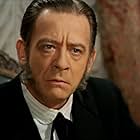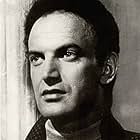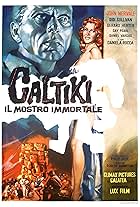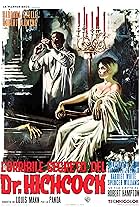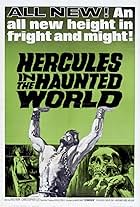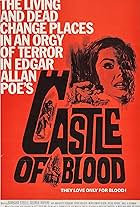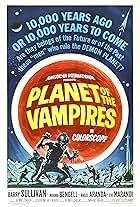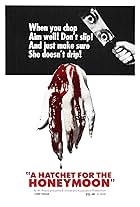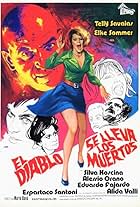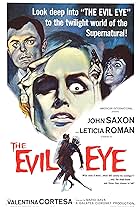Paris. Young girls are found dead, drained of their blood. A journalist investigates these murders while the beautiful Gisele, from a noble family, tries to seduce him.Paris. Young girls are found dead, drained of their blood. A journalist investigates these murders while the beautiful Gisele, from a noble family, tries to seduce him.Paris. Young girls are found dead, drained of their blood. A journalist investigates these murders while the beautiful Gisele, from a noble family, tries to seduce him.
Carlo D'Angelo
- L'ispettore Chantal
- (as Carlo d'Angelo)
Angelo Galassi
- Ronald Fontaine
- (as Angiolo Galassi)
Antoine Balpêtré
- Il professor Julien du Grand
- (as Antoine Balpetré de la Comédie Française)
Armando Annuale
- Un uomo anziano al funerale
- (uncredited)
Larry Boston
- Unknown Role
- (uncredited)
Aristide Catoni
- Porter
- (uncredited)
Riccardo Freda
- Un medico
- (uncredited)
Bert Goldstein
- Il maitre d'
- (uncredited)
Ronny Holiday
- Nora
- (uncredited)
Joy Holliday
- Anita
- (uncredited)
Storyline
Did you know
- TriviaThis was the first Italian made horror film of the sound era.
- GoofsThe crime lab doctor says type O blood is the rarest blood type when, in fact, it is found in over 40% of the French population.
- Quotes
Il professor Julien du Grand: You'll feel nothing.
Laurette Robert: No!
Il professor Julien du Grand: It's much better this way.
Laurette Robert: No! No!
Il professor Julien du Grand: Such of you--alright, now, just be a good little girl!
- Crazy creditsEnglish dubbed version 'The Devil's Commandment' is credited to director Riccardo Freda's pseudonym Robert Hampton.
- Alternate versionsOriginal Italian version is 82-minutes long. US distributor re-edited the film, inserting new footage starring Al Lewis and Ronny & Joy Holliday, shortened it to 70 minutes and released it as "Devil's Commandment". The differences are as follows:
- Alternate opening scene in which Joseph (played by a body double) stalks a women to her apartment, kills her in the bathtub, and has the body disposed of.
- Several dialogue-heavy scenes are cut or trimmed.
- The scene where Lantin brings the police back to the apartment he tailed Joseph back to is cut.
- The scene where the blind beggar is questioned by the police, and the subsequent house raid, are cut.
- A newly-shot sequence where a woman goes to a nightclub and is subsequently killed by Joseph.
- A newly-shot sequence where one of Dr. Du Grand's assistants (Lewis) forces himself on Lorette (played by a body double).
- Added insert shots of rats crawling toward Lorette.
- ConnectionsReferenced in Mario Bava: Maestro of the Macabre (2000)
Featured review
This is notable for being the first Italian horror film, thus spearheading a rich Gothic vein which ran well into the 1970s (one of three strands of horror which emerged simultaneously the others being the so-called "Mexi-Horror" and Britain's Hammer brand-name). Curiously enough, I had never heard of the film when it turned up on late-night Italian TV some years ago but loved it immediately and, having erased the tape, I'd been pondering the idea of picking up the Image DVD ever since its release but, only now, with Anchor Bay's recent issue of THE MARIO BAVA COLLECTION VOL. 1 Box Set did I determine to spring for it! Rewatching I VAMPIRI now and, having in the meantime amassed quite a few titles made in this style, I can safely say that it was a tremendous start to the subgenre and remains one of its finest examples.
Due to a dispute with the producers, Freda left the project after 10 days' shooting; Bava eventually completed the film and, during the remaining 2 day's work, reportedly made considerable changes to its plot structure (which should have allotted him a co-director credit a similar situation subsequently arose during the making of the horror/sci-fi CALTIKI, THE IMMORTAL MONSTER [1959]). Bava's cinematography lends the film a real class transcending its obvious low-budget and tight schedule with any number of sweeping camera moves (to take advantage of the Cinemascope format) and incredible lighting effects. Besides, the transformation of the villainess from a beautiful woman into an old hag are masterfully accomplished in-camera through the use of filters (pretty much in the style of DR. JEKYLL AND MR. HYDE [1931]). The sets, especially the elaborate castle interior, are suitably impressive; Roman Vlad's powerful score may have been re-used in later films, as it felt oddly familiar to me.
The script does seem to naively approach the new genre by piling on typical elements from the American horror films, such as the mad scientist and his sinister-looking 'zombie' acolyte. However, there's no real vampire at work here but rather rejuvenation by blood transfusion; perhaps, it was thought that the traditional bloodsucker would seem incongruous or, worse, laughable amidst a modern-day Parisian backdrop, but this clash of settings actually works very nicely (and may well have influenced EYES WITHOUT A FACE [1959] which, in its way, proved even more seminal to the horror genre). Besides, we get an unusual emphasis on the antagonistic rapport between the reporter hero and the police inspector in charge of the crime spree; following a splendid climax, the latter provides a long-winded last-minute explanation for the benefit of the viewer which, basically, became a fixture of Italian horror/thriller efforts.
It's also interesting that the hero, ultimately, establishes the source of evil as being much closer to home than he could ever have imagined; in fact, he represents the object of desire for wicked noblewoman Gianna Maria Canale (probably cast because she was Freda's lover at the time, but there's no denying that her classical looks and natural sophistication are perfect for the role). Still, even if the reporter falls for a lovely ingénue and does bear a grudge against Canale, his aggressive aversion to the latter isn't credible: he should have been fascinated by her in spite of himself, thus creating an inner conflict for the hero. As it stands, one is merely moved to see Canale cling pathetically to an unrequited love for which she debases herself by being driven to crime in order to re-obtain a semblance of youth (a scheme which still backfires on her, as the effect only lasts for short periods of time)!
The latter drawback leads, incidentally, to a head-scratching scene towards the end of the film: Canale runs into the hero, who accompanies her to buy a painting she starts reverting to her true decrepit age while writing a cheque, excuses herself and hurries away to 'safety'. This, somehow, arouses the reporter's suspicion (why he should care whether she is right or left-handed is beyond me, but her behavior appears odd even to the shop-owner) and he promptly phones a colleague who had accompanied him the night before to a party given at the castle the latter, smitten with the lady, had stayed behind and, consequently, discovers that his friend has vanished! Euro-Cult favorite Paul Muller's haunted, hunted look makes him ideal for the role of the hapless junkie who's, basically, blackmailed into complying with the doctor and the Duchess's perverse experiment. Curiously enough, Freda had originally intended him to be guillotined and subsequently reassembled; this grisly end, however, was dropped when Bava took over but the stitching marks on his neck are said to be still visible in a scene where the re-animated Muller is grilled by Police (still, not being aware of his altered fate beforehand, I can't say that I noticed)!
Interestingly, I VAMPIRI fared poorly at the box-office; this has been attributed to the Italian people's innate skepticism of a home-grown horror product, thus giving rise to the long-running and often highly amusing practice of bestowing cast and crew members with English-sounding names! With respect to the American market, then, the film was bafflingly retitled THE DEVIL'S COMMANDMENT and included additional scenes featuring Al Lewis (later of the horror-spoof TV series THE MUNSTERS)!!
Due to a dispute with the producers, Freda left the project after 10 days' shooting; Bava eventually completed the film and, during the remaining 2 day's work, reportedly made considerable changes to its plot structure (which should have allotted him a co-director credit a similar situation subsequently arose during the making of the horror/sci-fi CALTIKI, THE IMMORTAL MONSTER [1959]). Bava's cinematography lends the film a real class transcending its obvious low-budget and tight schedule with any number of sweeping camera moves (to take advantage of the Cinemascope format) and incredible lighting effects. Besides, the transformation of the villainess from a beautiful woman into an old hag are masterfully accomplished in-camera through the use of filters (pretty much in the style of DR. JEKYLL AND MR. HYDE [1931]). The sets, especially the elaborate castle interior, are suitably impressive; Roman Vlad's powerful score may have been re-used in later films, as it felt oddly familiar to me.
The script does seem to naively approach the new genre by piling on typical elements from the American horror films, such as the mad scientist and his sinister-looking 'zombie' acolyte. However, there's no real vampire at work here but rather rejuvenation by blood transfusion; perhaps, it was thought that the traditional bloodsucker would seem incongruous or, worse, laughable amidst a modern-day Parisian backdrop, but this clash of settings actually works very nicely (and may well have influenced EYES WITHOUT A FACE [1959] which, in its way, proved even more seminal to the horror genre). Besides, we get an unusual emphasis on the antagonistic rapport between the reporter hero and the police inspector in charge of the crime spree; following a splendid climax, the latter provides a long-winded last-minute explanation for the benefit of the viewer which, basically, became a fixture of Italian horror/thriller efforts.
It's also interesting that the hero, ultimately, establishes the source of evil as being much closer to home than he could ever have imagined; in fact, he represents the object of desire for wicked noblewoman Gianna Maria Canale (probably cast because she was Freda's lover at the time, but there's no denying that her classical looks and natural sophistication are perfect for the role). Still, even if the reporter falls for a lovely ingénue and does bear a grudge against Canale, his aggressive aversion to the latter isn't credible: he should have been fascinated by her in spite of himself, thus creating an inner conflict for the hero. As it stands, one is merely moved to see Canale cling pathetically to an unrequited love for which she debases herself by being driven to crime in order to re-obtain a semblance of youth (a scheme which still backfires on her, as the effect only lasts for short periods of time)!
The latter drawback leads, incidentally, to a head-scratching scene towards the end of the film: Canale runs into the hero, who accompanies her to buy a painting she starts reverting to her true decrepit age while writing a cheque, excuses herself and hurries away to 'safety'. This, somehow, arouses the reporter's suspicion (why he should care whether she is right or left-handed is beyond me, but her behavior appears odd even to the shop-owner) and he promptly phones a colleague who had accompanied him the night before to a party given at the castle the latter, smitten with the lady, had stayed behind and, consequently, discovers that his friend has vanished! Euro-Cult favorite Paul Muller's haunted, hunted look makes him ideal for the role of the hapless junkie who's, basically, blackmailed into complying with the doctor and the Duchess's perverse experiment. Curiously enough, Freda had originally intended him to be guillotined and subsequently reassembled; this grisly end, however, was dropped when Bava took over but the stitching marks on his neck are said to be still visible in a scene where the re-animated Muller is grilled by Police (still, not being aware of his altered fate beforehand, I can't say that I noticed)!
Interestingly, I VAMPIRI fared poorly at the box-office; this has been attributed to the Italian people's innate skepticism of a home-grown horror product, thus giving rise to the long-running and often highly amusing practice of bestowing cast and crew members with English-sounding names! With respect to the American market, then, the film was bafflingly retitled THE DEVIL'S COMMANDMENT and included additional scenes featuring Al Lewis (later of the horror-spoof TV series THE MUNSTERS)!!
- Bunuel1976
- May 20, 2007
- Permalink
Details
- Release date
- Country of origin
- Language
- Also known as
- The Vampires
- Filming locations
- Titanus Studios, Rome, Lazio, Italy(Studio, as Titanus - Appia)
- Production companies
- See more company credits at IMDbPro
- Runtime1 hour 22 minutes
- Color
- Aspect ratio
- 2.35 : 1
Contribute to this page
Suggest an edit or add missing content










